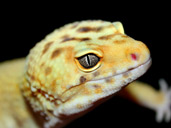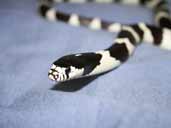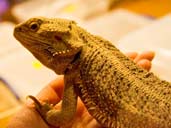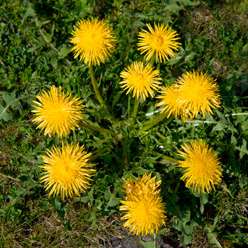The Reptilian Forum
The Reptilian forum is a place for members to share good practice and ask questions about their exotic pets and their general care. It is free to register and easy to use. There are plenty of regular members, so any queries about exotic animal care, exotic animal breeding, exotic animal health and keeping should be answered within a short space of time.
Frequently Asked Questions.
I do not understand the meaning of some of the things mentioned on the forum and care sheets. Have you got a glossary?
Yes, we have a simplified list of common reptile related terms and abbreviations on our Glossary page. This list was compiled with those new to reptile keeping in mind, so covers all the basics, but also has a list of some of the slang words regulary referred to in exotic pet focused forums.
What Reptile species make good pets for new and in-experienced Reptile keepers?
There are a few species that are commonly kept in captivity that are quite hardy, so are more suitable for beginners than some other types of reptile.
If you are interested in keeping a lizard then Leopard Geckos and Bearded Dragons are relatively easy to care for. A good beginner’s choices for new snake keepers include Corn snakes and King snakes, both of which are easy to care for and grow to a handleable size. If are interested in keeping a tortoise then Hermann’s and Horsefield tortoises are generally the easiest to care for in comparison to other species of tortoise, but their care is a little more complex than that of the other reptiles mentioned above, so should be considered an intermediate species rather than a beginners.
When making a decision on which type of reptile is right for you research should play a key role in your preparations. All reptiles that can be kept in captivity should be researched extensively by both beginners and experienced keepers before they are purchased. It is always important to be 100% certain you can provide the care needs required for that species, regardless of your experience with reptiles.
 |
 |
 |
 |
Corn Snake |
Leopard Gecko Eublepharis macularius |
King Snake Lampropeltis getula |
Bearded Dragon Pogona vitticeps |
What types of heating devices can be used in a Reptile enclosure?
The type of heat source that you will require for an enclosure depends on the type of exotic pet that you are going to house inside it. It is important to research the needs of your chosen species thoroughly to understand what heat source is most suitable for the optimum health and happiness of your pet.
Here is a quick list of some popular heating devices with a brief description of their suitability:
-
Heat Mats/strips – are the most common heating device used in exotic pet keeping. They can be attached to the bottom or the side of a enclosure and are most suited to small sized, nocturnal reptiles that do not require U.V, like many colubrid snakes and some geckos and other exotics like inverts and amphibians. Available in a variety of sizes to suit most vivaria.
-
Ceramic bulbs – are suitable for raising the ambient air temperature within an enclosure and are suggested for many reptiles including heavy bodied snakes. They are capable of creating infrared, radiant heat from above, but are non-light emitting, so if used with a basking species it may need to be twined with U.V lighting. A heat resistant socket is recommended with ceramics.
-
Heat Bulbs- provide heat and light within an enclosure so are suitable for diurnal species. Various types on the market, so capabilities should be checked before being purchased as some may emit UVA, UVB or Infrared or a combination of all three. One drawback is that to produce heat there must also be light, so an additional heat source may be required if a specific photo-period is required. Using specific night (red coloured) and day (blue coloured) bulbs is also an option.
-
Basking Lamps – are suitable for exotic species that would naturally bask in the rays of the sun in the wild. They offer a concentrated heat that shines down in a narrow area, so that the reptile would need to position itself directly underneath to feel the effects.
-
Mercury vapour bulbs- offer combined benefits as they radiate intense heat, light and UV. This makes them only suitable for large (4ft plus) open or well ventilated vivariums and for species that demand high UV.
-
Heat cable- generally used in vivarium stacks and racking systems. They offer localised heat in the same way that a heat mats do, meaning that they warm the area that is directly in contact with it and not the surrounding air.
-
Advanced heating systems (AHS) - ideal for large enclosures and for use with heavy-bodied boids and lizards. Many advanced heating systems have intergrated thermostats and guards, so seperate safety equipment may not be necessary.
-
Reptile Radiators - are efficient carbon element heaters that can be fixed to the roof of a vivarium. They are non-light emitting, reliable and have the added benefit of radiating heat directly below to warm the ambient air. Suitable for basking species if twined with UV lighting. Seperate heat guard is required to protect your pet from burns.
-
Aquarium heaters – raise the water temperature in an aquarium and are suitable for aquatic species, incuding turtles, terrapins and some amphibians. These tend to have a thermostat integrated into the device, so an external thermostat is not always necessary.
-
Heat rocks – used to be popular in reptile keeping, but are no longer recommended due to the increased risk of your reptile becoming burnt. They are also considered to be a fire hazard.
Are thermostats necessary for controlling the temperature in my reptile’s enclosure?
Yes. All heat sources within a vivarium or terrarium should be controlled by a suitable thermostat. The optimal temperature for your pet is dependent on species, but many exotics can suffer if their enclosure is either too hot or too cold. If temperatures are too low, you are risking your reptile’s health as they are more prone to digestive disorders and respiratory infections (R.Is). Too high and you are risking heat stress, dehydration and death, as most reptiles, even ones that appreciate higher temperatures have little tolerance to excessive heat. A thermostat will regulate the heat source and ensure that your reptile will remain at a safe temperature, so the benefits of a thermostat far outweigh the small expense of this vital piece of equipment.
There are various types of thermostat on the market and they are all readily available from reptile shops and online. The 3 main kinds of thermostat are Pulse Proportional, Dimmer and Mat Stats. Pulse Proportional thermostats control the temperature by emitting electrical pulses and are best used with ceramic heaters. Dimmer or dimming stats are known for their accuracy and are suitable for many devices, but particularly heat bulbs and lamps. Mat Stats are simple on/off thermostats and should only ever be used with heat mats or strips.
Another piece of equipment that is essential for the safety of your reptile is a heat guard. Heat guards prevent your pet from coming into contact with a heat source and offer vital protection from burns.
What type of food do Reptiles eat?
Reptiles can be insectivores, carnivores, or herbivores depending on the species you have, with some eating from two or more of the three food types, choosing a mixture of insects, rodents, birds and vegetable matter (omnivores). It is important to check as many care sheets and books specifically about your species of reptile to find out what foods are suitable for your pet to eat.
Most reptile species appreciate variety in their diet and it is not healthy to feed your reptile on just one type of food alone, unless they would naturally live on a single staple diet in the wild. Both frozen (rodents and day old chicks) and live foods (insects) are widely available from reptile stockists and online.
Frozen rodents are suitable for snakes in particular, but some reptiles and amphibians may also take a small mouse occasionally. The mice will need to be kept within a freezer and thawed for a few hours prior to feeding your pet. Frozen mice are preferable to live rodents, because live feeding can be hazardous for both the mouse and the reptile if things do not go as planned. Rodents have sharp teeth and strong jaws and so will inflict considerable damage onto a reptile in a flight or fight situation. It is advised to only feed live rodents in an emergency, such as when a non-feeding snake has become seriously underweight by refusing food in any other form.
Many reptiles are both insectivores and omnivores, meaning that insects will be included in their diet. All feeder insects should be gut-loaded prior to feeding to your reptiles. Gut-loading is the practice of feeding your insects with highly nutritious food items that will make the feeder insects more beneficial to the health of your reptile. Prepared gut-loading formulas can be purchased from reptile suppliers, but it is also very simple to give your insects a nutritious diet without ready-made products. Green vegetables and salad leaves are packed with vitamins and in most cases provide all the water needed to keep your insects healthy. Other good food items that can be used for gut-loading are oats, bran, flaked fish food and calcium-rich foods like dandelion leaves and powdered milk powder. Carrot and potato peelings are also usually readily taken by most feeder insects.
Insects should be dusted with vitamins and calcium prior to being fed to your pets, but research should be done to find out how frequently your species of reptile requires vitamins and minerals. The simplest way to dust your insects is using the ‘shake and bake’ method, where you place some of your vitamin and calcium powder into a plastic tub or bag, followed by your insects and shake them together until the food item is completely covered in powder, then serve.
Although live foods are easily purchased, many keepers do try and culture their own feeder insects within the home. If you are interested in try this yourself then the care sheet page features information on some of the common insects kept for this purpose, highlighting how they can be bred and maintained.
 A few reptiles live completely on an herbivorous diet, which means that they survive by eating vegetable, fruit and plant matter. Some lizards and most tortoises will source all of their food from plants, so it is important to offer the most nutritious salads, flowers, and vegetables to make sure they are obtaining the healthiest balance of calcium, plant-proteins and fibre. The majority of a herbivorous reptile’s diet should consist of calcium-rich vegetables, such as dandelion leaves, Spinach, Parsley, Mustard and Turnip greens and dark green lettuces (not Iceberg Lettuce as this has no nutritional value). The rest of the diet can be made up of other vegetables (like broccoli, carrots, sprouts, peppers), fruits (apple, strawberries, bananas, oranges, kiwis, tomatoes), wholegrain cereals/prepared reptile foods, flowers, and protein-rich foods like beans (plant proteins are better for reptiles than animal proteins). It is important to note that even a well-balanced herbivorous diet will still need to be supplemented regularly with additional vitamins, minerals and calcium.
A few reptiles live completely on an herbivorous diet, which means that they survive by eating vegetable, fruit and plant matter. Some lizards and most tortoises will source all of their food from plants, so it is important to offer the most nutritious salads, flowers, and vegetables to make sure they are obtaining the healthiest balance of calcium, plant-proteins and fibre. The majority of a herbivorous reptile’s diet should consist of calcium-rich vegetables, such as dandelion leaves, Spinach, Parsley, Mustard and Turnip greens and dark green lettuces (not Iceberg Lettuce as this has no nutritional value). The rest of the diet can be made up of other vegetables (like broccoli, carrots, sprouts, peppers), fruits (apple, strawberries, bananas, oranges, kiwis, tomatoes), wholegrain cereals/prepared reptile foods, flowers, and protein-rich foods like beans (plant proteins are better for reptiles than animal proteins). It is important to note that even a well-balanced herbivorous diet will still need to be supplemented regularly with additional vitamins, minerals and calcium.
All vegetables, fruits and flowers that are offered to your reptile should be fresh, clean and obtained from a source that is guaranteed to be pesticide/chemical free. This goes for both collected plant matter like dandelion leaves and shop bought vegetables that are suitable for human consumption, but are not organic. Many reptile keepers choose to grow their own plants to ensure that the food they are giving to their reptiles are safe and many packet seeds can be found in local shops and online for this purpose.
What plants are safe to use in a Reptile vivarium?
Ensuring the suitability of any live plant that you are considering to place within the vivarium/terrarium is very important, as some plants may be toxic to your reptile. You should always research a new species of plant that you want to use in the vivarium, to ensure that it is safe to use and that it will not be an irritant to your pet. You should also ensure that the plant is suitable for the conditions within the terrarium; otherwise it may wither and die if conditions such as temperature, light and humidity are not suitable for it.
Some popular plants to use in reptile housing include bromeliads, ferns such as the Bird’s Nest Fern & Java Fern, Wandering Jew, Creeping Fig, Live Moss such as Java Moss, Orchids, Aloe Vera, Asters, Spider plants, various succulents and Draeceana. Live plants should always be sourced from somewhere that you can guarantee that they have been grown using fertilizer-free methods to avoid any chemicals being introduced to your reptile’s home.
There is a ‘Set up’ section on the main forum if you have any more questions about the suitability of certain plants for you reptile set up.
Are Reptiles susceptible to any health problems?
Reptile illness can usually be avoided through good husbandry, as Reptiles that are without clean vivaria, fresh water and a balanced diet are more susceptible to disease and illness than reptiles who are given appropriate care.
Some of the common illnesses in reptiles include Mites (external parasites), Internal parasites, Impaction (a blockage in the digestive tract), Stress and MPD (Metabolic Bone Disease caused by insufficient calcium in an Reptile’s diet). Most of these illnesses can be avoided, but if you believe your reptile is suffering from any of the above then it is advisable to see a specialised exotics vet as soon as possible.
Still got questions?
Then please enter the forum. Our regular members will answer any exotic pet related question and it would be great to welcome you into TheReptilian.co.uk community.

